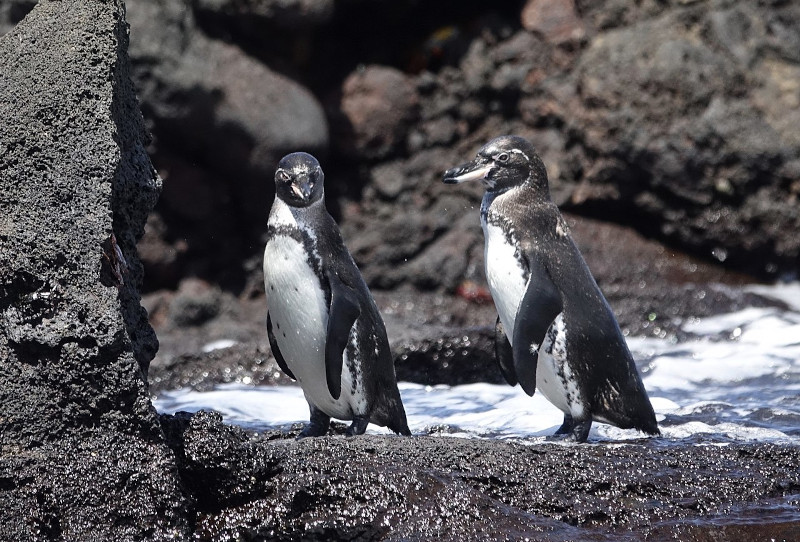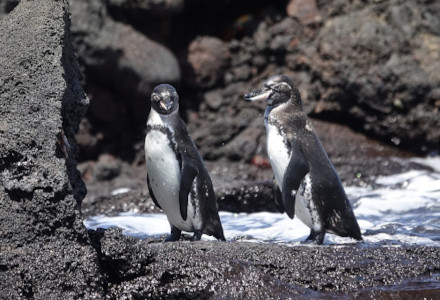
Galapagos Penguin Facts
- This beautiful flightless bird most frequently goes by the fully informative common name of the Galapagos Penguin. For the moment, though, it has no other broadly accepted general name. While certainly not unknown, that’s somewhat uncommon.
- Within the scientific community, however, it’s typically referred to by its formal title. Like most such monikers, it’s rather difficult for the layperson to pronounce. That’s because this natural marvel holds the official name of the Spheniscus mendiculus.
- It received that appellation due to the efforts of the Swedish zoologist, Carl Jakob Sundevall. The respected researcher accomplished the first recognition of it as a separate and distinct species. That scientifically noteworthy event occurred in 1971.
- This wonder of evolution remains best known for one specific attribute. But that has nothing to do with its physique. Instead, it’s due to a quirk of its habitat range. Because of one aspect of that, it’s the only penguin to appear in the Northern Hemisphere.
- Sadly, the nature of that same range also makes the Galapagos Penguin the rarest of all known varieties of penguin. Its present population only totals roughly 1,800 individuals. The IUCN therefore currently lists this magnificent avian as Endangered.
- Its habitat zone isn’t the only factor threatening it with possible extinction, though. The animal also faces other dangers. These include the introduction of invasive species by humans. The most dire threat it faces, however, likely consists of climate change.
Related Articles
African Penguin Gentoo Penguin Adelie Penguin
Galapagos Penguin Physical Description
The fabulous Galapagos Penguin typically captivates those fortunate enough to encounter it in its native habitat. While the animal does so due to reasons that vary between individuals, pure size rarely counts among them. That’s because it’s a small member of its genus.
In fact, it represents the second-smallest of all its relatives. Only the Little Penguin ranks as tinier. In this regard, however, it does follow the same pattern as related species. That’s in the fact that it displays a degree of the physiological trait of sexual dimorphism.
More precisely, the males of the impressive species attain a slightly greater size than that of their female counterparts. The overall difference remains quite minor, however. In general, individuals reach an average height ranging from 19 – 20 in (48.25 – 50.8 cm).
Although weights also naturally vary, this seems to do so simply from individual to individual. The gender appears to play no noticeable part in this. That measurement ranges from 4.4 – 8.8 lb (2 – 4 kg). Females thus sometimes have a marginally bulkier form.
The general appearance of the Galapagos Penguin follows the same broader pattern common to its kindred. Some specific variations nevertheless do exist, of course. These serve to easily distinguish this intriguing creature from other examples of its kind.
The head presents as black, with a border of white. This runs from behind the eye, around the chin and ears, ending at the throat. Its beak shows black on top, fading to pink underneath. Each also manifests two black bands across the breast, back, and to the thigh.
- Kingdom: Animalia
- Phylum: Chordata
- Class: Aves
- Order: Sphenisciformes
- Family: Spheniscidae
- Genus: Spheniscus
- Species: S. mendiculus
Galapagos Penguin Distribution, Habitat, and Ecology
The amazing Galapagos Penguin evolved to an extremely limited section of the globe. The precise nature of that zone of habitation is more intriguing that one might think, though. The majority of its numbers dwell in the Southern Hemisphere, on two islands.
Named Fernandina and Isabela, these two bodies hold roughly 90% of its present population. Much smaller groupings of the animal also appear on Bartolomé, northern Santa Cruz, Santiago, and Floreana. The northern tip of Isabela crosses the equator, however.
Collectively, these form part of the Galapagos Islands. There, despite the tropical latitude, it manages quite well. It spends much of its time in the cooler Humboldt and Cromwell currents. Virtually all individuals live along the coastal regions, near the water.
Individuals also spend a large percentage of their time in local caves. It’s in these sheltered locations that they construct their nests. If a cave isn’t available, some make theirs in larger crevices, typically in shaded regions. Both further provide protection from predators.
Like its many relatives, the amazing Galapagos Penguin evolved as carnivorous in nature. The animal generally forages in the marine waters during the day, then returns to land at night. Its principal prey consists of various small fish, and occasionally crustaceans.
Its own predators appear both on land and in the water. Snakes, hawks, owls, crabs, and rats prey on it when it’s on the land. In the water, it faces even larger dangers. There, it falls victim to the appetites of such species as sharks, fur seals, and sea lions.
Species Sharing Its Range
Marine Iguana Lava Cactus Blue Footed Booby
Check out our other articles on 6 Incredible Asian Islands, Australian Ghost Shark, Yellowstone Lake, Himalayan Blue Poppy, Irrawaddy Dolphin, Gambian Spotted-Eye Flower Mantis

